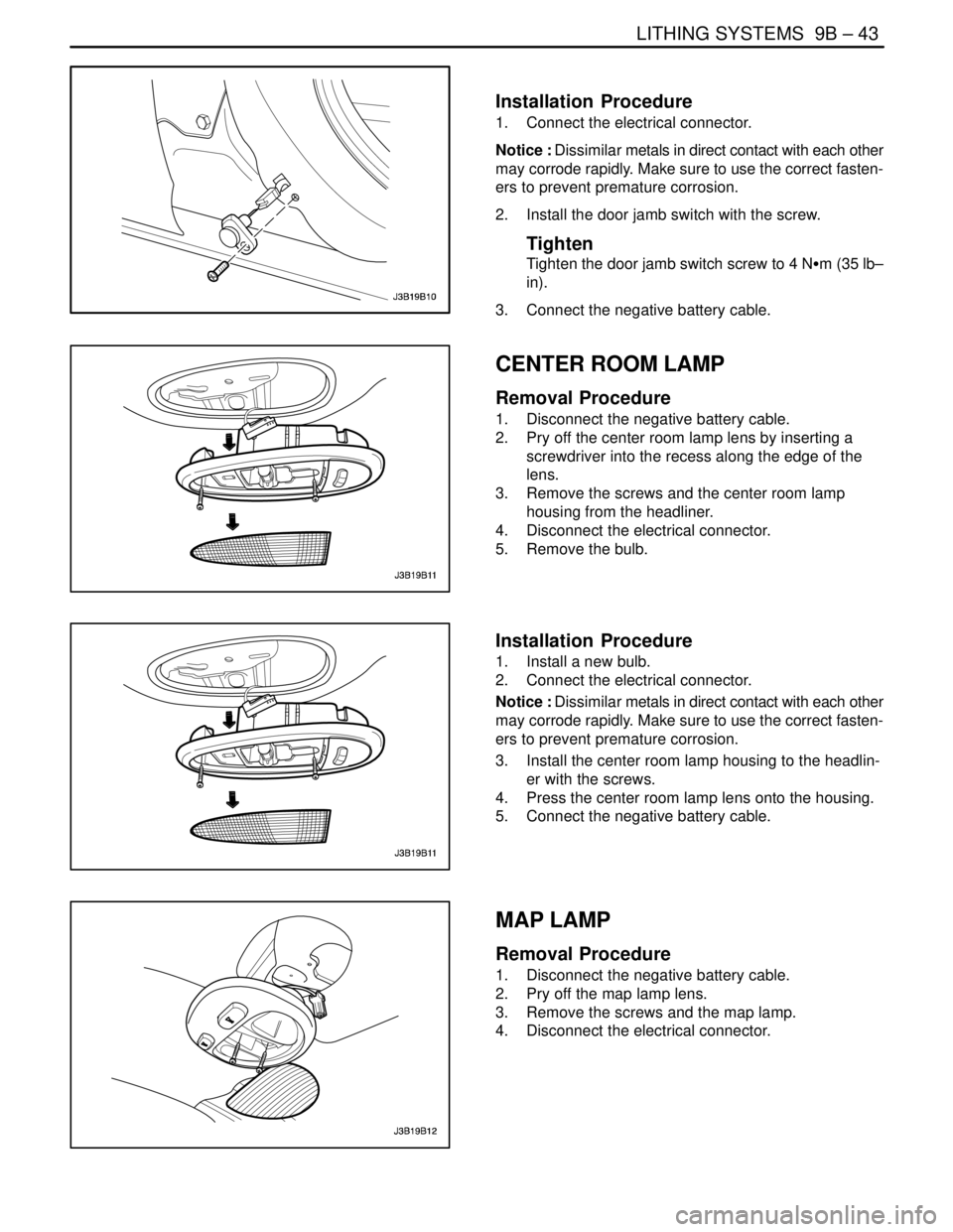2004 DAEWOO NUBIRA MAP
[x] Cancel search: MAPPage 1399 of 2643

5A1 – 50IZF 4 HP 16 AUTOMATIC TRANSAXLE
DAEWOO V–121 BL4
TCC shudder should only occur during the APPLY and/or
RELEASE of the Lock up clutch.
While TCC Is Applying Or Releasing
If the shudder occurs while TCC is applying, the problem
can be within the transaxle or torque converter.
Something is not allowing the clutch to become fully en-
gaged, not allowing clutch to release, or is trying to release
and apply the clutch at the same time. This could be
caused by leaking turbine shaft seals, a restricted release
orifice, a distorted clutch or housing surface due to long
converter bolts, or defective friction material on the TCC
plate.
Shudder Occurs After TCC Has Applied :
In this case, most of the time there is nothing wrong with
the transaxle! As mentioned above, once the TCC has
been applied, it is very unlikely that will slip. Engine prob-
lems may go unnoticed under light throttle and load, but
become noticeable after TCC apply when going up a hill
or accelerating, due to the mechanical coupling between
engine and transaxle.
Important : Once TCC is applied there is no torque con-
verter assistance. Engine or driveline vibrations could be
unnoticeable before TCC engagement.
Inspect the following components to avoid misdiagnosis of
TCC shudder and possibly disassembling a transaxle and/
or replacing a torque converter unnecessarily :
S Spark plugs – Inspect for cracks, high resistance or
broken insulator.
S Plug wires – Lock in each end, if there is red dust
(ozone) or black substance (carbon) present, then
the wires are bad. Also look for a white discolor-
ation of the wire indicating arcing during hard accel-
eration.
S Distributor cap and rotor – look for broken or un–
crimped parts.
S Coil – look for black on bottom indication arcing
while engine is misfiring.
S Fuel injector – filter may be plugged.
S Vacuum leak – engine won’t get correct amount of
fuel. May run rich or lean depending on where the
leak is.S EGR valve – valve may let it too much unburnable
exhaust gas and cause engine to run lean.
S MAP sensor – like vacuum leak, engine won’t get
correct amount of fuel for proper engine operation.
S Carbon on intake valves – restricts proper flow or
air/fuel mixture into cylinders.
S Flat cam – valves don’t open enough to let proper
fuel/air mixture into cylinders.
S Oxygen sensor – may command engine too rich or
too lean for too long.
S Fuel pressure – may be too low.
S Engine mounts – vibration of mounts can be multi-
plied by TCC engagement.
S Axle joints – checks for vibration.
S TPS – TCC apply and release depends on the TPS
in many engines. If TPS is out of specification, TCC
may remain applied during initial engine starting.
S Cylinder balance – bad piston rings or poorly seal-
ing valves can cause low power in a cylinder.
S Fuel contamination – causes poor engine perfor-
mance.
TCM INITIALIZATION PROCEDURE
When one or more operations such as shown below are
performed, all learned contents which are stored in TCM
memory should be erased after the operations.
S When A/T H/W is replaced in a vehicle,
S When a used TCU is installed in other vehicle,
S When a vehicle condition is unstable (engine RPM
flare, TPS toggling and so on; at this kind of unsta-
ble conditions, mis–adaptation might be done).
1. Connect the Scan 100 with a DLC connector in a
vehicle.
2. Turn ignition switch ON.
3. Turn the power on for the Scan 100.
4. Follow the ”TCM LEARNED INITIALIZE” procedure
on the Scan 100 menu.
Notice : Before pushing ”Yes” Button for TCM initialization
on the Scan 100 screen, make sure that the condition is
as follows:
Condition :
1. Engine idle.
2. Select lever set ”P” range.
Page 2219 of 2643

BODY WIRING SYSTEM 9A – 13
DAEWOO V–121 BL4
FUSE CHART
Engine Room Fuse Block
FuseRating/SourceCircuit
EF130AB+Battery Main (F13~F16, F21~F24)
EF260AB+EBCM, Oil Feeding Connector
EF330AB+Blower Relay
EF430AB+Ignition Switch–2
EF530AB+Ignition Switch–1
EF620AB+Cooling Fan Low Relay
EF730AB+Defog Relay
EF830AB+Cooling Fan HI Relay
EF920AIGN 2Power Window Switch
EF1015AIGN 1Fuel Connector, ECM (MR–140), LEGR, EI Sys-
tem
EF1110AB+ECM, Main Relay (Sirius D4)
EF1225AB+Head Lamp Relay, ILLUM. Relay
EF1315AB+Brake Switch
EF1420AIGN 2Power Window Switch
EF1515ALightHead Lamp HI
EF1615AB+Horn Relay, Siren, Hood Contact Switch
EF1710AB+A/C Comp. Relay
EF1815AIGN 1Fuel Pump
EF1915AB+Cluster, Key Remind S/W, Folding Mirror Unit,
MAP Lamp, Room Lamp, Trunk Open Lamp,
Trunk Open S/W
EF2010ALightHead Lamp Low
EF2115AIGN 1/B+EVAP Canister Purge Solenoid, HO2S, Cooling
Fan Relay
EF2215AIGN 1/B+Injector, EGR, EEGR
EF2310AIlluminationLicense Plate Lamp, Chime Bell, Tail Lamp,
Head Lamp
EF2415AB+Fog LampRelay
EF2510AIGN 2Electric OSRV Mirror
EF2615AB+Central Door Lock Unit
EF2710ALightHead Lamp Low
EF2810AIlluminationILLUM. Circuit, Head Lamp, Tail Lamp
EF2910ASpareNot Used
EF3015ASpareNot Used
EF3125ASpareNot Used
Page 2227 of 2643

SECTION : 9B
LIGHTING SYSTEMS
CAUTION : Disconnect the negative battery cable before removing or installing any electrical unit or when a tool
or equipment could easily come in contact with exposed electrical terminals. Disconnecting this cable will help
prevent personal injury and damage to the vehicle. The ignition must also be in LOCK unless otherwise noted.
TABLE OF CONTENTS
SPECIFICATIONS9B–2 . . . . . . . . . . . . . . . . . . . . . . . . . .
Bulb Usage Chart 9B–2. . . . . . . . . . . . . . . . . . . . . . . . . .
Fastener Tightening Specifications 9B–2. . . . . . . . . . .
SCHEMATIC AND ROUTING DIAGRAMS9B–3 . . . . .
Backup Lamps Circuit 9B–3. . . . . . . . . . . . . . . . . . . . . .
Instruments Circuit (W/O Dimmer Control :
General Only) 9B–4. . . . . . . . . . . . . . . . . . . . . . . . . . .
Instruments Circuit (W/ Dimmer Control) 9B–5. . . . . .
Front And Rear Fog Lamps Circuit 9B–6. . . . . . . . . . .
Headlamps–On Reminder Chime Circuit 9B–7. . . . . .
Headlamps and Headlamp Leveling Circuit 9B–8. . . .
Daytime Running Lamps Circuit 9B–9. . . . . . . . . . . . .
Parking, Tail and License Lamps Circuit 9B–10. . . . . .
Stoplamps Circuit 9B–11. . . . . . . . . . . . . . . . . . . . . . . . .
Turn and Hazard Lamps Circuit 9B–12. . . . . . . . . . . . .
Interior Courtesy and Luggage Compartment Lamp
Circuit 9B–13. . . . . . . . . . . . . . . . . . . . . . . . . . . . . . . . .
DIAGNOSIS9B–14 . . . . . . . . . . . . . . . . . . . . . . . . . . . . . . .
Headlamps–On Reminder Chime 9B–14. . . . . . . . . . .
Headlamps 9B–16. . . . . . . . . . . . . . . . . . . . . . . . . . . . . .
Headlamp Leveling 9B–20. . . . . . . . . . . . . . . . . . . . . . .
Daytime Running Lamps 9B–22. . . . . . . . . . . . . . . . . . .
Parking Lamps and Taillamps 9B–23. . . . . . . . . . . . . .
Interior Courtesy and Luggage Compartment
Lamps 9B–31. . . . . . . . . . . . . . . . . . . . . . . . . . . . . . . . .
Fog Lamps 9B–34. . . . . . . . . . . . . . . . . . . . . . . . . . . . . .
MAINTENANCE AND REPAIR9B–36 . . . . . . . . . . . . . .
ON–VEHICLE SERVICE 9B–36. . . . . . . . . . . . . . . . . . . . Headlamps/Front Turn Signal Lamps 9B–36. . . . . . . .
Daytime Running Lamp Module 9B–37. . . . . . . . . . . . .
Parking Lamps 9B–37. . . . . . . . . . . . . . . . . . . . . . . . . . .
Side Turn Signal Lamps 9B–38. . . . . . . . . . . . . . . . . . .
Front Fog Lamps 9B–38. . . . . . . . . . . . . . . . . . . . . . . . .
Notchback Rear Combination Lamps 9B–39. . . . . . . .
Hatchback Rear Combination Lamps 9B–40. . . . . . . .
Hatchback Extension Lamps 9B–40. . . . . . . . . . . . . . .
Notchback Center High–Mounted Stoplamp 9B–41. .
Hatchback Center High–Mounted Stoplamp 9B–41. .
License Plate Lamps 9B–42. . . . . . . . . . . . . . . . . . . . . .
Door Jamb Switch 9B–42. . . . . . . . . . . . . . . . . . . . . . . .
Center Room Lamp 9B–43. . . . . . . . . . . . . . . . . . . . . . .
Map Lamp 9B–43. . . . . . . . . . . . . . . . . . . . . . . . . . . . . . .
Luggage Compartment Lamp 9B–44. . . . . . . . . . . . . . .
Ashtray and Cigar Lighter Lamp 9B–44. . . . . . . . . . . .
GENERAL DESCRIPTION AND SYSTEM
OPERATION9B–46 . . . . . . . . . . . . . . . . . . . . . . . . . . . . .
Headlamps–On Reminder Chime 9B–46. . . . . . . . . . .
Headlamps 9B–46. . . . . . . . . . . . . . . . . . . . . . . . . . . . . .
Daytime Running Lamps 9B–46. . . . . . . . . . . . . . . . . . .
Parking and Turn Signal Lamps 9B–46. . . . . . . . . . . . .
Fog Lamps 9B–46. . . . . . . . . . . . . . . . . . . . . . . . . . . . . .
Rear Combination Lamps 9B–46. . . . . . . . . . . . . . . . . .
License Plate Lamp 9B–46. . . . . . . . . . . . . . . . . . . . . . .
Interior Courtesy Lamp 9B–46. . . . . . . . . . . . . . . . . . . .
Luggage Compartment Lamp 9B–46. . . . . . . . . . . . . . .
Backup Lamps 9B–47. . . . . . . . . . . . . . . . . . . . . . . . . . .
Page 2228 of 2643

9B – 2ILIGHTING SYSTEMS
DAEWOO V–121 BL4
SPECIFICATIONS
BULB USAGE CHART
BulbReplacement Bulb Number
Backup Lamp21W
Center High–Mounted Stoplamp5W
Front Fog Lamp27W
Headlamp55W
Interior Courtesy Lamp10W
License Plate Lamp5W
Luggage Compartment Lamp10W
Park and Front Turn Signal LampDouble 21/5W
Rear Fog Lamp21W
Rear Turn Signal Lamp21W
Side Turn Signal Lamp5W
Taillamp and StoplampDouble 21/5W
FASTENER TIGHTENING SPECIFICATIONS
ApplicationNSmLb–FtLb–In
CHMSL Mounting Nuts4–35
Door Jamb Switch Screw4–35
Front Fog Lamp Nuts4–35
Headlamp Assembly Bolts and Nuts4–35
License Plate Lamp Screws4–35
Map Lamp Screws1.5–13
Rear Combination Lamp Assembly Screws4–35
Hatchback Extension Lamp3–27
Page 2269 of 2643

LITHING SYSTEMS 9B – 43
DAEWOO V–121 BL4
Installation Procedure
1. Connect the electrical connector.
Notice : Dissimilar metals in direct contact with each other
may corrode rapidly. Make sure to use the correct fasten-
ers to prevent premature corrosion.
2. Install the door jamb switch with the screw.
Tighten
Tighten the door jamb switch screw to 4 NSm (35 lb–
in).
3. Connect the negative battery cable.
CENTER ROOM LAMP
Removal Procedure
1. Disconnect the negative battery cable.
2. Pry off the center room lamp lens by inserting a
screwdriver into the recess along the edge of the
lens.
3. Remove the screws and the center room lamp
housing from the headliner.
4. Disconnect the electrical connector.
5. Remove the bulb.
Installation Procedure
1. Install a new bulb.
2. Connect the electrical connector.
Notice : Dissimilar metals in direct contact with each other
may corrode rapidly. Make sure to use the correct fasten-
ers to prevent premature corrosion.
3. Install the center room lamp housing to the headlin-
er with the screws.
4. Press the center room lamp lens onto the housing.
5. Connect the negative battery cable.
MAP LAMP
Removal Procedure
1. Disconnect the negative battery cable.
2. Pry off the map lamp lens.
3. Remove the screws and the map lamp.
4. Disconnect the electrical connector.
Page 2270 of 2643

9B – 44ILITHING SYSTEMS
DAEWOO V–121 BL4
Installation Procedure
1. Connect the electrical connector.
Notice : Dissimilar metals in direct contact with each other
may corrode rapidly. Make sure to use the correct fasten-
ers to prevent premature corrosion.
2. Install the map lamp with the screws.
Tighten
Tighten the map lamp screws to 1.5 NSm (13 lb–in).
3. nstall the map lamp lens.
4. Connect the negative battery cable.
LUGGAGE COMPARTMENT LAMP
Removal Procedure
1. Disconnect the negative battery cable.
2. Remove the luggage compartment lamp.
3. Disconnect the electrical connector.
4. Remove the bulb.
Installation Procedure
1. Install a new bulb.
2. Connect the electrical connector.
3. Install the luggage compartment lamp.
4. Connect the negative battery cable.
ASHTRAY AND CIGAR LIGHTER
LAMP
Removal Procedure
1. Disconnect the negative battery cable.
2. Remove the bulb housing.
3. Remove the bulb from the bulb housing.